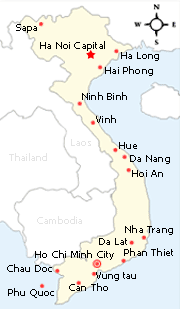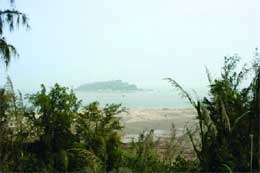|
Seaside city
Heavy industry was a natural choice thanks to its proximity to coal supplies, and afterwards a shipbuilding industry and cement, glass, porcelain, and textile works were established. One of the most immediate causes of the War of Independence was the infamous French bombardment of the “native quarters” of Haiphong in 1946, in which hundreds of civilians were killed and injured. A contemporary French account estimated civilian deaths at more than 6,000. After the French departed and Vietnam declared independence in 1954, the silted-up harbor was reconstructed with Chinese and Soviet aid, and the docks and shipbuilding yards were repaired and modernised. The old French cement plant was enlarged, and fish-canning, chemical-fertiliser, machine-tool and additional textile industries were established. Haiphong came under US air and naval attack between 1965 and 1972. In May 1972 President Nixon ordered the mining of Haiphong Harbour to cut the flow of Soviet military supplies to North Vietnam. As part of the Paris cease-fire accords of 1973, the US agreed to help clear the mines from Haiphong Harbour – 10 US navy mine-sweepers were involved in the effort. Since Vietnam’s reunification in 1975, Haiphong has grown to become an important industrial and commercial centre, and is now the nation’s third most populous city. Today you can you can still see traces of Haiphong’s colonial past – the city’s courthouse and theatre are classic examples of French architecture. Less opulent housing is also prominent. The city is filled with what can be described as typically modern Vietnamese architecture. The thin, tall houses that sprout up the roadside are not an architectural style but the result of landowners owning a thin sliver of land. Over the past two decades, many of the city’s former colonial houses have also been modified, but you can still see elaborate iron gates and columns. The Cua Cam River splits the northern side of Haiphong city. To the West is the relatively new Binh Bridge, Vietnam’s second biggest cabled-stayed bridge and a striking landmark for Haiphong. Opened in 2005, it provides a vital link between the city and the surrounding rural areas, stimulating economic activities in the region and bringing the social and cultural services of the city within better reach of the rural population. South of Haiphong port is the city centre, a bustling spot that never seems to pause for a moment’s rest. The city is famous for its “hoa phuong”, or “flamboyant flower”, which blooms from trees above the pathways forming a brilliant red canopy. The flower has become a symbol of Haiphong city, which is sometimes called “Phoenix flower city”. If you’d like to escape the city centre, head for Nui Voi, which literally means Elephant Mountain, in An Lao district. Nui Voi is said to look like a huge elephant lying between paddy fields and a blue sky. There you can find a bronze sword and other relics from the time of the Dong Son, the prehistoric Bronze Age culture that was centered at the Red River Valley of northern Vietnam, which flourished from about 1000 to 1BCE. At Long Hoa pagoda, a wooden bell is sounded to create a heavenly, Zen-like atmosphere. Nui Voi is also where Phan Ba Vanh made a stand against Emperor Minh Mang of the Nguyen Dynasty. The charismatic leader died on the battlefield on March 12, 1827, after six years of constant rebellion. After some sightseeing, it’s time to head for the beach! Do Son is a small peninsula located between the Lach Tray and Van Uc Rivers. The beaches here are nicely shaded by thousands of sandalwood trees and surrounded by mountains and pine hills. Around the hills there are French-style constructions looking towards the sea. Since 1975, Do Son has become a popular weekend sea resort and today both Vietnamese and foreign tourists flock here during the summer months. Thanks to its geographical and cultural advantages, Haiphong is emerging as one of the most appealing destinations for tourists and foreign investors in Vietnam. Haiphong’s authorities aim to make this seaport the foremost industrialized and modern city in the country. How to get there: Buses leave from Gia Lam Bus Station every hour. VietNamNet/Time-out
Other news for Sunday 23 August, 2009
View all news for Sunday 23 August, 2009 on one page News for Tuesday 18 August, 2009
View all news for Tuesday 18 August, 2009 on one page Recent News
|










